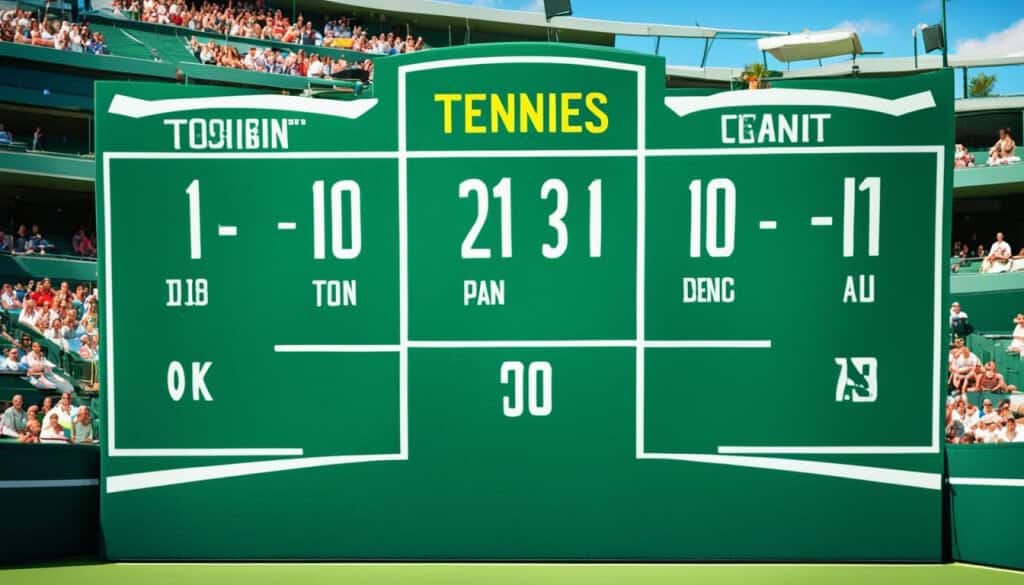In tennis, “love” means a score of zero. It’s key to understanding how tennis scoring works. The term “love” in tennis might come from the French word for egg, ‘l’oeuf’. This could be because the zero looks like an egg. Or it might be linked to playing ‘for the love of the game’ itself. Grasping what “love” means helps in fully understanding tennis scores, moving from love to 15, 30, then 40.
Understanding “love” in tennis is more than keeping track of points. It shows the sport’s rich traditions and fun details. This special word for zero makes tennis stand out. It’s one of the many unique parts of the game.
Key Takeaways
- “Love” in tennis scoring means a score of zero.
- It may come from the French ‘l’oeuf’ or mean playing for the love of the game.
- Knowing what “love” means is key to enjoying and playing tennis.
- Tennis scores start at love, then increase by 15, 30, and 40, with specific rules to win.
- Words like “love” in scoring show tennis’s long history and cultural importance.
The Intriguing Origin of ‘Love’ in Tennis Scoring
The term love in tennis scoring is quite fascinating. Many people, from tennis buffs to sports history enthusiasts, wonder about its beginnings. It comes from the deep, interesting story of tennis scoring history. This story keeps people curious and wanting to know more. Unlike most sports, tennis has its own way of keeping score. For example, it uses ‘love’ for zero. Some think it relates to the French word ‘l’oeuf’ because they look alike. Another idea is that ‘for love’ means playing just for fun. This makes the game more about joy and sportsmanship, not money.
Looking deeper into where ‘love’ in tennis comes from, both ideas tell us about the sport’s changes and effect on society over time. It’s important to compare these ideas to see what they say about tennis today.
| Theory | Description | Cultural Impact |
|---|---|---|
| ‘l’oeuf’ (egg) | Alludes to the zero shape, linking the score of zero in tennis to the shape of an egg. | Highlights the French influence on the early development of tennis, embedding a playful element into the game. |
| ‘For love’ | Suggests that early games were played for the pleasure of the sport, not for financial gain. | Emphasizes the purity and passion for tennis, impacting its perception as a noble and ethical sport. |
From its fun beginnings to its noble reputation, the origin of love in tennis is quite intriguing. When players and fans say ‘love,’ they’re part of tennis’s deep history. It connects them to the culture of the sport.
What is Love in Tennis: Unpacking the Scoreboard
In tennis, the scoreboard tells a story. It shows the match’s suspense and the strategies used. Let’s look at how tennis scoring works and what makes it unique.
From Love to Deuce: The Progression of Points
Tennis scoring starts at love (zero) and moves to 15, then 30, and finally 40. This system shows a player’s progress in a game. It also highlights the importance of being precise and using mental tactics. Deuce is when both players reach 40. It means someone must win by two points to take the game. This part adds a lot of excitement to tennis matches.
Why Forty and Not Forty-Five?
Have you wondered why tennis goes from 30 to 40, skipping 45? The change happened long ago, possibly because scoring used to be like telling time on a clock. Using simple quarter marks made it easy to record scores. So, 40 became the go-to score instead of 45.
The Anomaly of the Tennis Tiebreak System
The tennis tiebreak system is quite unique. It was made to make matches shorter. When players are tied at 6 games each in a set, a tiebreak comes in. Here, they both try to be the first to reach 7 points with a 2-point lead. This system changes the game, focusing on skill and keeping calm under pressure.

Grasping the progression of points and the reason for jumping to 40, along with the tennis tiebreak, shows how tennis mixes skill and tactics. This makes every match an exciting story of numbers and decisions.
Expressions Beyond Love: Other Unique Tennis Scoring Terms
Tennis has a rich language beyond “love.” It’s filled with special words and phrases that add flavor to the game’s history. When a player wins a set 6-0, we call it a “bagel.” This funny term makes the win’s dominance clear, using the shape of a zero like a doughnut.
There’s also the “dinner set,” marking a player’s victory at all four big tournaments. These are Wimbledon, the French Open, the US Open, and the Australian Open. The term “seed” refers to the top-ranked players. It comes from the idea of planting seeds in a row to help plants grow well.
The word “let” is about a serve that touches the net but lands right in the service box. When this happens, the point is played again. From “bagel” to “seed” and “let,” each term tells a story. They show the deep culture and details of tennis. This makes the game even more interesting to follow.
























































